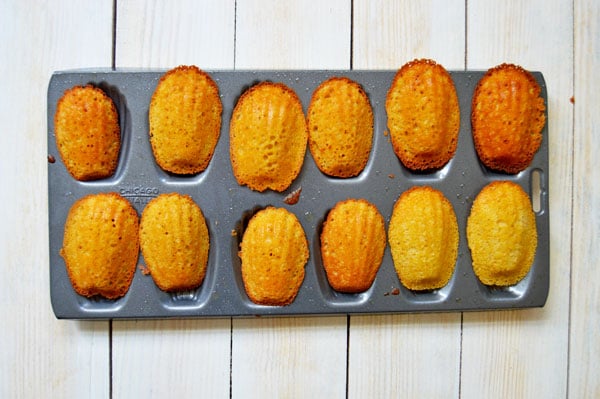
Earlier this year, I had the opportunity to meet chef Daniel Boulud at the IACP (International Association of Culinary Professionals) Conference in Washington D.C. He was at the conference for Jacques Pepin’s 80th Birthday Celebration and was wandering around mingling with guests during the party.
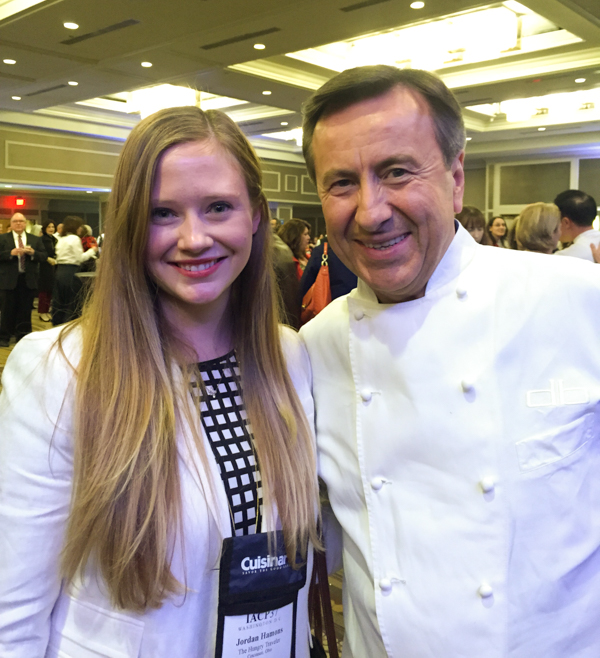
With Daniel Boulud in Washington DC
When I realized his restaurant DBGB Kitchen was across the street from our hotel, I gathered a few friends and made a reservation for Sunday brunch. The good thing about hanging out with food people is that you never have to try very hard to convince them to join you for a meal (especially at a famous chef’s restaurant).
All of my friends jumped at the chance and we snuck out of the conference during our lunch break. We had a wonderful lunch and even lost track of time and missed the next session at the conference. By the time we realized our mistake, it was too late to make it back for the meeting and we decided to go ahead and order dessert. The tender, buttery, lemony and absolutely perfect warm madeleines were the highlight of the meal and I’ve been thinking about them ever since.
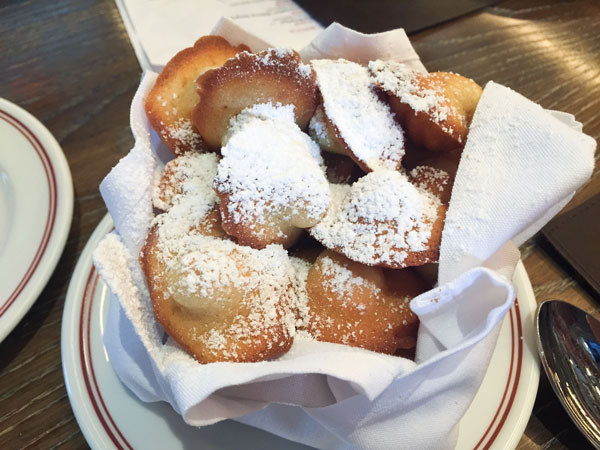
Basket of warm madeleines at DBGB Kitchen
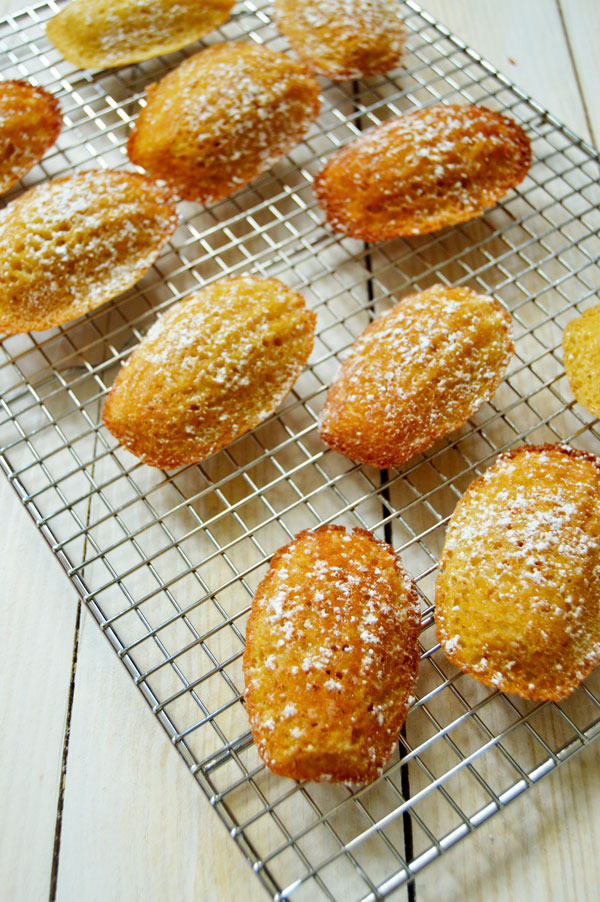
The History of Madeleines
Madeleines, small cakes made in a scallop shell mold, are one of the most celebrated traditional French pastries. According to the Oxford Companion to Sugar and Sweets, madeleines are believed to have originated in the eighteenth century at the chateau of Stanislaw Leszczynski, the father-in-law of Louis XV. The name came from one of the kitchen’s elderly cooks, Madeleine Paulmier. Madeleines are characterized by the scallop shell pattern on one side and a small hump on the back. Traditionally, they are served with a dusting of powdered sugar or a light glaze.
Madeleines were made famous by the writer Marcel Proust when he wrote about them in his novel A la recherche du temps perdu (known in English as In Search of Lost Time or Remembrance of Things Past). In the famous passage, a middle-aged Proust takes a bit of a madeleine, one of his favorite childhood snacks, and it brings back memories that he had long forgotten.
Today, madeleines can be flavored in nearly anyway imaginable, from chocolate to jam-filled, and even savory with cheese and herbs. Some of the best madeleines are found in Paris at Blé Sucré but, in the US, I recommend the madeleines from DBGB.
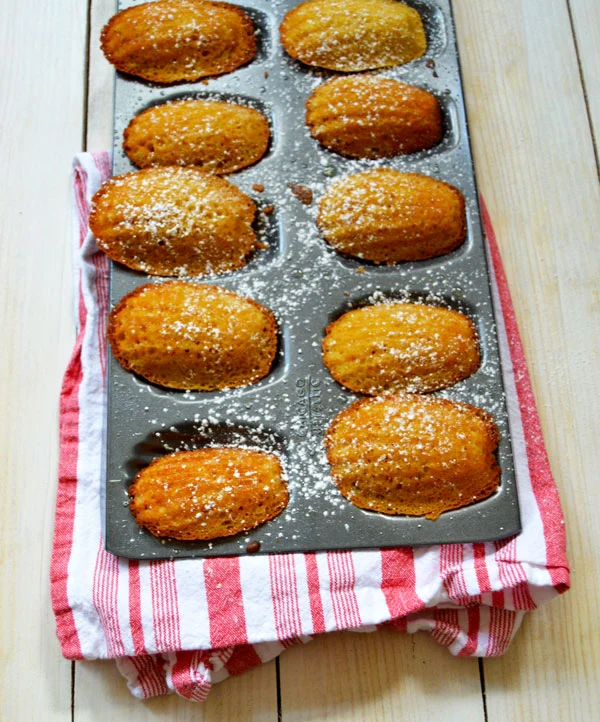
Equipment & Tools
Here are few special tools that are helpful for making madeleines:
Nonstick Madeleine Pan – it’s not a madeleine without the signature shape!
Portion Scoop – the easiest way to get the batter into the pan.
Stand Mixer – A stand mixer works best but a hand mixer will work too
Fine Mesh Strainer – the best tool for getting an even dusting of powdered sugar on top
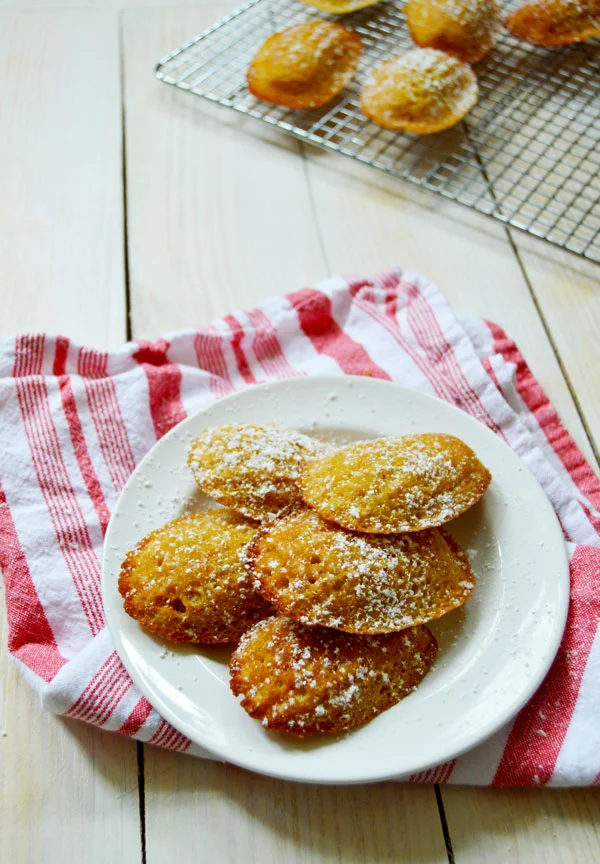
Tips & Tricks
Madeleines can be incredibly quick to bake if you work wisely. Here’s what I do: I start by getting the butter melting and browning. While that’s happening, I scale my ingredients. In one bowl, I measure the flour, baking powder and salt and give them a quick whisk. In the stand mixer bowl, I add the eggs, sugars, honey, vanilla extract, and lemon zest. By the time my ingredients are ready, the butter is a toasty brown. I scrape that into a measuring cup and put it in the freezer to cool it down. While the butter is chilling, I start whisking the egg mixture and folding in the flour, then proceeding with the rest of the recipe.
When working with brown butter, be sure to scrape all of the brown bits out of the pan. They tend to stick but these are the browned milk solids and where most of the flavor comes from.
In order to get the signature hump on the back of madeleines, chill the batter before baking. I don’t include this in the recipe because I find the madeleines taste the same with or without the bump on the back and I like to keep my baking simple and quick. David Lebovitz recommends chilling the batter for one hour before putting it into the molds and then for another hour after the batter is in the molds.
Place the madeleine pan on a baking sheet before placing it in the oven. The madeleine pan has a lip on the bottom that gets caught on the oven rack and is difficult to grab with oven mitts. Placing it on a baking sheet makes it much easier to transfer in and out of the oven.
For a complete primer on baking madeleines, check out the wonderful book Madeleines by Barbara Feldman Morse.
Jordan Hamons | [The Hungry Traveler|http://www.thehungrytravelerblog.com" target="_blank]
Yields 24
25 min
12 min
37 min
Ingredients
1 stick (8 tablespoons / 113 grams) unsalted butter
1 cup (120 grams) all purpose flour
1 teaspoon (5 grams) baking powder
1/2 teaspoon (3 grams) kosher salt
3 (150 grams) large eggs
1/3 cup (67 grams) granulated sugar
1/4 cup (53 grams) lightly packed light brown sugar
1 tablespoon (21 grams) honey
1 teaspoon (4 grams) vanilla extract
2 teaspoons freshly grated lemon zest
Powdered sugar
Instructions
Position a rack in the center of the oven and preheat the oven to 350 degrees. Coat two 12-shell madeleine pans with baking spray.
Melt the butter in a small saucepan over medium heat. Let the butter simmer until it is a toasted brown color and has a nutty aroma. There will be dark brown flecks (those are the milk solids) throughout. Remove the pan from the heat and pour the butter into a heat proof measuring cup to cool, making sure to scrape in any brown flecks that are left in the pan (those are the flavor!).
In a medium bowl, whisk together the flour, baking powder and salt. Set aside.
Place the eggs, sugars, and honey in the bowl of a stand mixer fitted with the whisk attachment. Mix on medium-high until the mixture is light in color, thick, and fluffy, about 5 minutes. Add the vanilla extract and lemon zest and mix until combined.
Remove the bowl from the mixer and fold in the flour mixture gently by hand. Once the flour is combined, gradually stream in the cooled melted butter and fold it into the mixture until completely incorporated. Be sure to scrape the bottom and sides of the bowl to make sure no pockets of flour or butter remain.
Using a small cookie scoop or a tablespoon, fill the molds with batter until they are almost completely full.
Bake the madeleines for 10-12 minutes or until puffed and golden brown. The madeleines should bounce back when pressed with the tip of your finger.
Let the madeleines cool in the pans for 3-5 minutes and then move to a wire rack. Serve warm sprinkled with powdered sugar.
Notes
Keep in an airtight container for up to for 2-3 days. The madeleines can also be frozen for up to 2 months and then reheated in the microwave or in a 350 degree oven before serving.
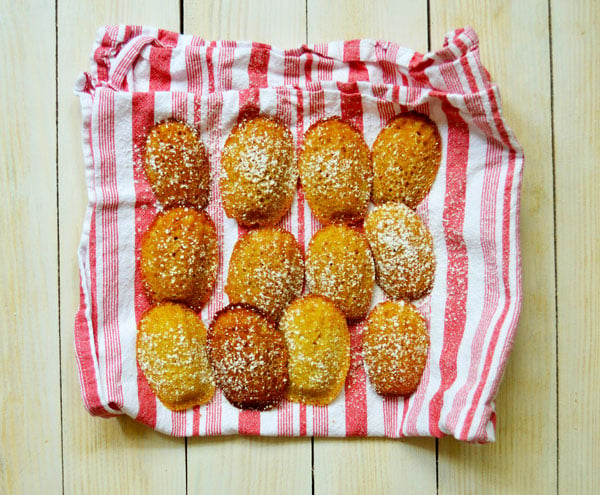

 Save Recipe
Save Recipe
Leave a Reply